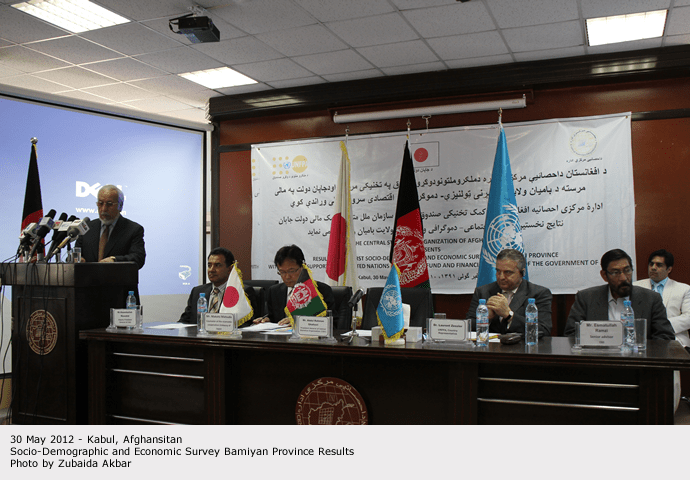Kabul, 30th May - Mr. Abdul Rahman Ghafoori, President of Central Statistics Organization (CSO), Dr. Laurent Zessler, UNFPA Representative, and Mr. Makoto Matsuda, Counselor of Economic Cooperation Section, Embassy of Japan in Kabul launched the Bamiyan Province Socio-Demographic and Economic Survey Results today at CSO Conference Hall.
"This activity is a milestone in the history of statistics in Afghanistan as this is the first large scale data collection activity since the 1979 population census", said Mr. Ghafoori. He further noted that CSO will continue to build and improve its capacity in order to plan, collect, process and analyze data even more efficiently, while also improve evidence-based planning, programme monitoring and project evaluation He likewise appealed to the donors to support the undertaking for the rest of the 31 provinces. He said that CSO should be able to complete the survey for all provinces by 2014.
Mr. Ghafoori also expressed his appreciation to UNFPA for the technical support of the survey, to the Government of Japan for funding SDES and to the Government of Denmark for funding the sketch mapping and listing activities in Bamiyan. He also thanked the Governor of Bamiyan for her commitment and dedication to improve the lives of her constituents and for recognizing the importance of data as instrumental to the development of her province.
The survey provides socio-demographic and economic indicators that are important for sustainable development of the province; population size by sex and age, education, mortality, employment, functional difficulty, source of drinking water, source of energy for cooking, heating, and lighting, materials of roof, walls, and floor, and other housing and household characteristics.
The SDES revealed that there were 368 thousand people in Bamiyan Province as of September 2011, 190 thousand males, and 178 thousand females or a sex ratio of 107 males for every 100 females. Half of the population of Bamiyan is 16 years old and below implying a young population in the province.
The literacy rate of population 15 years old and over in Bamiyan Province is 31.7%, i.e. 45.4% for males and 16.5% for females. These rates are higher than the country's literacy rate of 26%, 39% and 12% respectively.
Four in five women, (82.6%), were 10 years old and over, and had at least one child born. The average number of children per woman aged 15 to 49 years old was 4.1 children or 41 children for every 10 women.
SDES also recorded 49.6 thousand households, an average household size of 7.4 persons, slightly higher than the average at the national level (7.3 persons). Households used animal dung for heating and cooking, and solar power for electricity. Houses in Bamiyan Province were mostly made of wood for the roof (87.8% of households), with almost all floors made of mud (96.1%), and walls constructed with mud/dirt bricks (81.7%).
One in four households in Bamiyan (25.2%) had access to improved drinking water source (piped water - 10.3%, tube well borehole/protected well - 7.5 %, and protected spring - 7.4%). This is lower than the national's estimate of 27.2%.
"I congratulate CSO for the successful completion of the survey and I express UNFPA gratitude to the Governor of Bamiyan for the support and strong desire to obtain data on the smallest administrative unit, village and district at the provincial level which will help the province to design and prepare plans based on reliable data" said Dr. Laurent Zessler, UNFPA Representative in Afghanistan. He further added that UNFPA will continue to support CSO in conducting SDES in all provinces and such that data will be available for the country's sustainable development.
The SDES project was launched on 3 August 2011 in Bamiyan starting off with the sketch mapping and listing of the area. At the same time, training was held for about 500 Surveyors and Controllers, District Statistics Officers and Assistants in the Provincial Center and all six districts of the province. The enumeration phase followed in September 2011 throughout the entire villages and districts. The survey was extended for some time in some areas due to the difficulty encountered by the Surveyors in accessing the remote villages in some districts. After a six-month long data processing which included editing and coding of questionnaires, data entry, revalidation of data, data evaluation and analysis, results are now ready and available.
The project was successfully implemented by CSO with technical support of UNFPA and financial support of the Government of Japan. The Government of Denmark also extended its assistance in funding the sketch mapping and listing activities.


